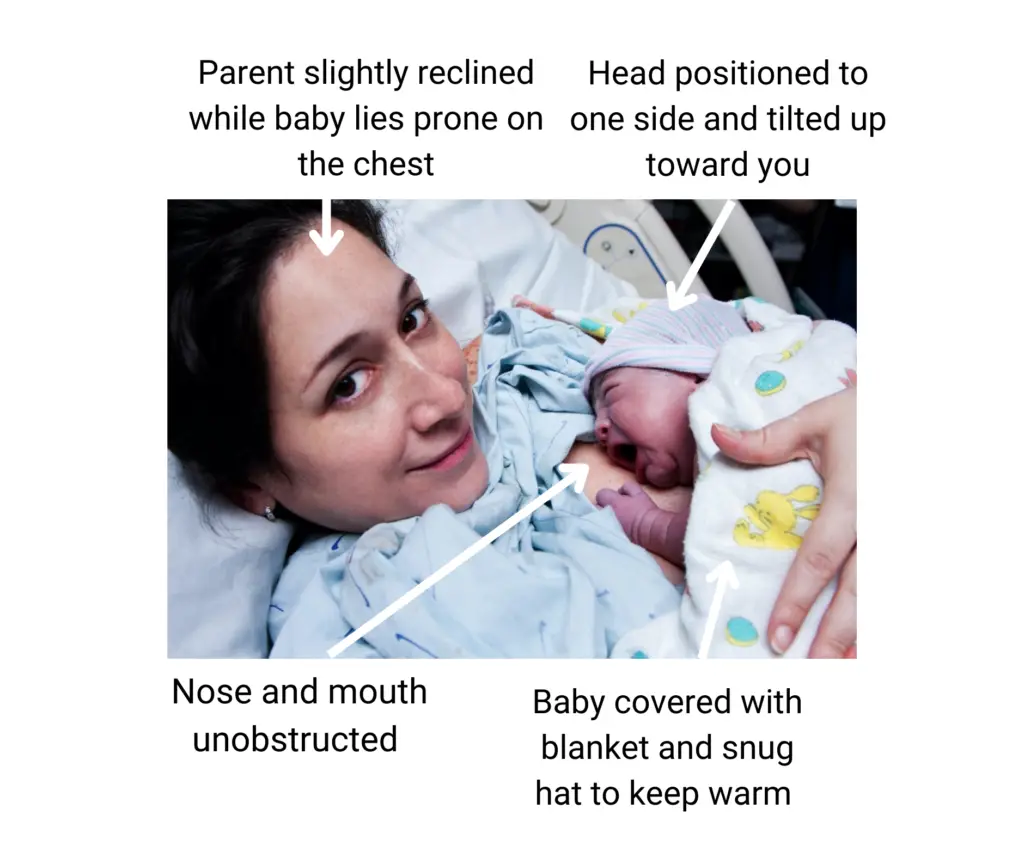
Example of safe skin-to-skin care in the newborn period. Photo Credit: Shutterstock
Skin-to-Skin Care to Promote Breastfeeding
Skin-to-skin care is the practice of placing a baby without clothing other than a diaper directly on a parent’s bare chest. It is thought to encourage latching, improve infant temperature regulation, and stimulate a hormone cascade that promotes milk production and bonding. It has also been shown in clinical trials to improve rates of breastfeeding among mothers who intend to breastfeed.[1]
But skin-to-skin care if done improperly can cause accidental bed sharing, newborn falls from bed, and even death from suffocation. Therefore, mothers in the immediate post-birth period should be closely monitored by a trained health professional for signs of fatigue during skin-to-skin care or breastfeeding. You should also ask for assistance if you feel like you are at risk of falling asleep or dropping your baby. Parents should also learn the following guidelines for safe skin-to-skin care.
The following is from the AAP guidelines on Safe Sleep and Skin-to-Skin Care in the Neonatal Period for Healthy Term Newborns [2] and is supplementary text to Chapter 7 of the Fed Is Best book.
Want to learn more about this topic?
Do you want to learn more about breastfeeding while ensuring safe and adequate feeding?
Dr. Christie and board-certified lactation consultant Lynnette Hafken have just released the online Fed Is Best Breastfeeding Course, where they discuss all the things that you will not hear from a breastfeeding book or class. In it they include secret tips and tricks that you normally have to pay hundreds of dollars to learn about, for the same cost of a hospital breastfeeding class. Click below to get in on the training!
Components of Safe Positioning for the Newborn While Doing Skin-to-Skin Care
|
From the AAP Policy: Safe Sleep and Skin-to-Skin Care in the Neonatal Period for Healthy Term Newborns
References
- Moore ER, Bergman N, Anderson GC, Medley N. Early skin-to-skin contact for mothers and their healthy newborn infants. Cochrane Database Syst Rev. 2016;11(11):CD003519. Published 2016 Nov 25. doi:10.1002/14651858.CD003519.pub4
- Feldman-Winter L, Goldsmith JP; COMMITTEE ON FETUS AND NEWBORN; TASK FORCE ON SUDDEN INFANT DEATH SYNDROME. Safe Sleep and Skin-to-Skin Care in the Neonatal Period for Healthy Term Newborns. Pediatrics. 2016;138(3):e20161889, https://doi.org/10.1542/peds.2016-1889.

